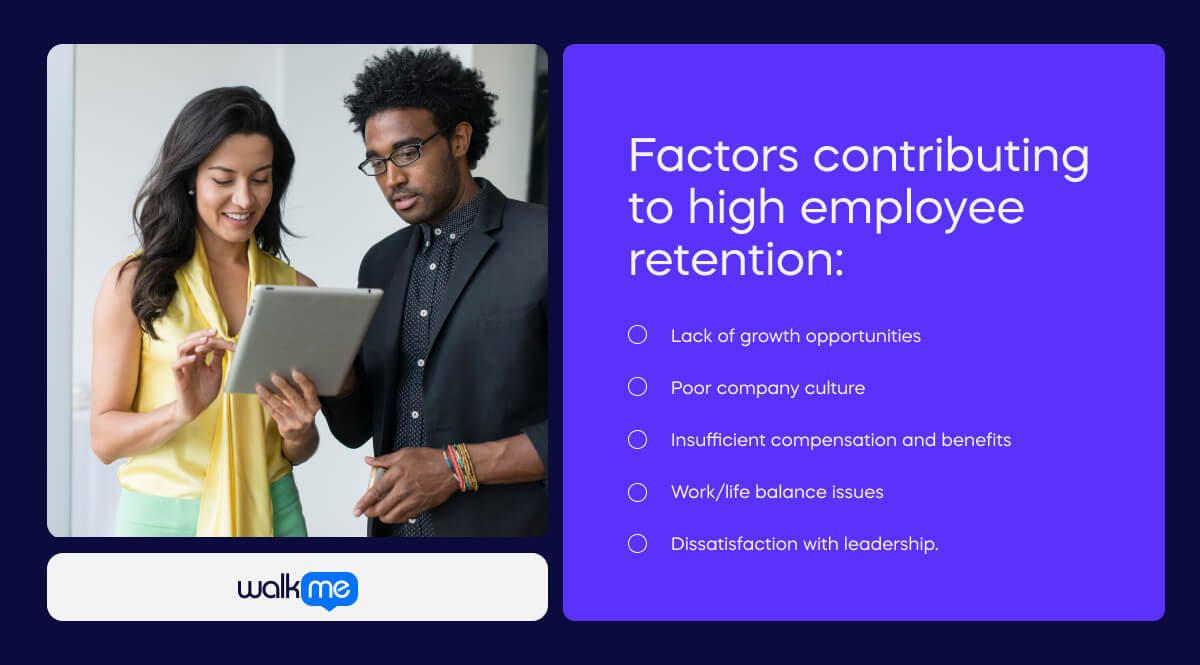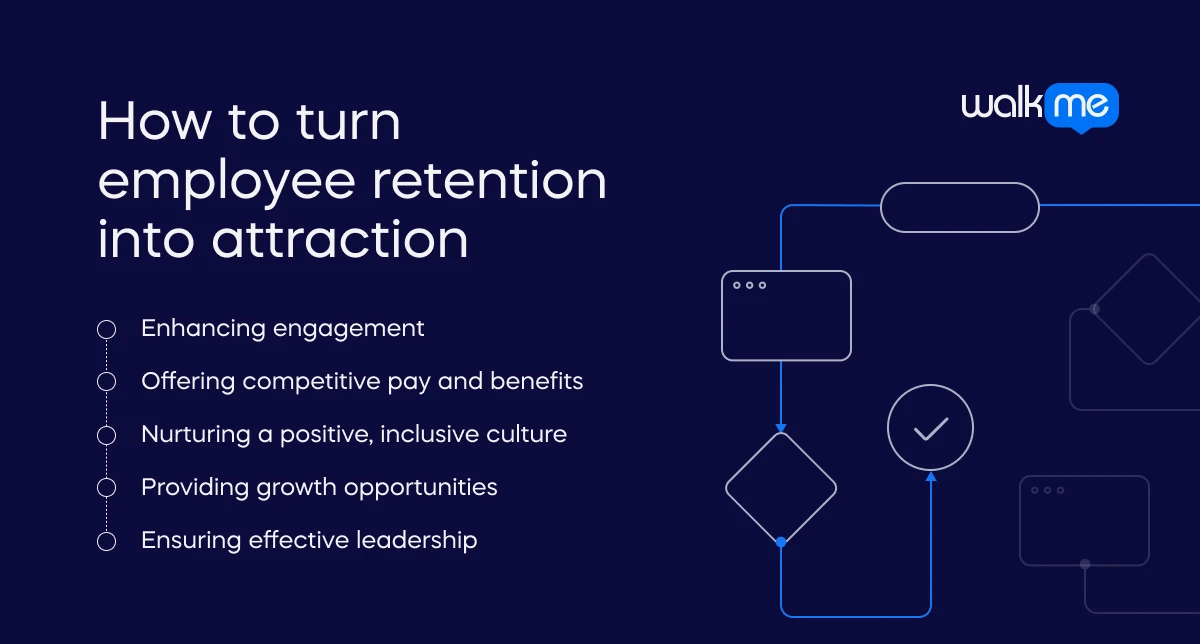What is employee retention?

Table of contents
- What is employee retention?
- How Do You Improve Employee Retention?
- How to understand employee retention
- What factors contribute to high employee retention?
- What is the Impact of employee retention on businesses?
- What are the benefits of employee retention?
- What are the challenges associated with employee retention?
- How to turn employee retention into attraction
- What does the future hold for employee retention?
How Do You Improve Employee Retention?
Employee retention is your ability to keep employees happy and engaged so they stay with your business for a meaningful time or through a challenging period.
Beyond that, it’s a measure of your organization’s health, as it marks whether you can foster a nurturing environment that cultivates talent and delivers a great employee experience.
It’s also a critical aspect of successful change management. Disruptive changes can shake employees from their comfort zones, prepare them to take action, and find new jobs elsewhere.
Business leaders have known for a long time that people are their most valuable asset.
And yet, businesses are hemorrhaging employees.
According to the US Bureau of Labor Statistics, more than 4.3 million people voluntarily quit their jobs in December 2021. According to McKinsey, 44% of those who quit have no interest in returning to traditional jobs.
How to understand employee retention
Employee retention, or employee churn, is the rate at which employees leave a company.
You can calculate your employee retention by taking the total number of employees who have left in a given period and dividing it by the average number of employees over that same period.
For example, if ten employees quit between January and June 2021, and the average number of employees during that time was 100, then the employee retention rate would be 10%.
Retention can be voluntary or involuntary. When employees quit their jobs willingly, it’s called voluntary retention. Involuntary retention is when an employee is laid off or fired due to a lack of work, budget cuts, etc.
Employee retention is a natural part of the business— it will always be there. However, with robust employee retention strategies, you can reduce the rate of voluntary retention within your company.
What factors contribute to high employee retention?

Many factors can contribute to high employee turnover.
Some of the most common ones include:
- Lack of growth opportunities
- Poor company culture
- Insufficient compensation and benefits
- Work/life balance issues
- Dissatisfaction with leadership.
When employees don’t feel appreciated or have the resources they need to do their jobs properly, they’ll likely look for another job elsewhere.
It’s important to understand why your employees are leaving so you can address any potential issues before they lead to departure from your organization.
What is the Impact of employee retention on businesses?
Employee retention can have a huge impact on businesses.
It’s estimated that the average cost to replace an employee is around 33% of their annual salary.
But beyond the financial costs, it also hurts morale and productivity within your company since new employees need time to get up to speed and integrate into the team.
Losing talented employees can also set back any projects they are working on, further affecting your bottom line.
Finally, high retention rates often lead to increased customer dissatisfaction. A lack of continuity in service delivery usually results in an inconsistent customer experience.
That’s why it’s crucial to understand why employees may be leaving and make a genuine and concerted effort to retain them.

What are the benefits of employee retention?
If the negative consequences of employee retention weren’t reason enough, there are also many compelling benefits of employee retention strategies.
Here are some of the benefits we think to carry the most weight:
Cost savings
Hiring new employees is an expensive process that involves recruitment, onboarding, and training costs, as well as productivity loss during the transition period.
You can save significantly on these costs by keeping employees for longer periods.
Increased productivity
Employees who have been with a company longer tend to be more efficient and better understand the company’s processes, leading to higher employee productivity.
They also typically require less supervision, freeing up time for management.
Better customer satisfaction
Long-standing employees often build strong relationships with clients and develop a deep understanding of their needs, resulting in improved customer service and satisfaction.
Knowledge retention
When employees leave, they take their expertise and knowledge with them.
You can maintain critical skills and knowledge within your organization by retaining employees.
Maintained company culture
Employees who stay with a company for a long time contribute to a stable, strong company culture.
This can foster a positive work environment that further promotes employee retention.
Employee morale
A low turnover rate can improve employee morale by creating a more stable work environment.
Conversely, high turnover can lead to job insecurity and lower morale among remaining employees.
Attracting talent
Companies that are known for high employee retention rates can attract top talent.
Candidates see these organizations valuing their employees and offering a stable work environment.
Business growth
Having continuity in the workforce enables long-term strategic planning and business growth.
With lower turnover, you can focus more on achieving future goals rather than constantly needing to replace departing staff.
What are the challenges associated with employee retention?
While the benefits of employee retention are undeniable, achieving high retention rates is not without its hurdles.
Here are some key challenges companies often face:
Competitive job market
In today’s talent-driven market, skilled employees have plenty of options. Retaining top performers requires offering competitive compensation, benefits, and career development opportunities.
Evolving employee expectations
Today’s workforce values flexibility, work-life balance, and a sense of purpose. Meeting these evolving expectations can be challenging for companies with traditional structures and mindsets.
Lack of engagement
Disengaged employees are more likely to leave. Fostering a culture of engagement through meaningful work, recognition, and opportunities for growth is crucial for retention.
Ineffective management
Poor management practices can drive employees away, such as lack of communication, unclear expectations, or micromanagement. Investing in leadership development and promoting a positive management culture is essential.
Limited growth opportunities
Employees who feel stagnant are more likely to seek opportunities elsewhere. Clear career paths, training programs, and mentorship can help retain ambitious talent.
Burnout and stress
Excessive workloads, long hours, and unrealistic deadlines can lead to burnout and high turnover. Promoting work-life balance, offering mental health resources, and encouraging time off can help prevent burnout.
Lack of recognition
Employees who feel undervalued or unappreciated are more likely to leave. Implementing regular recognition programs, both formal and informal, can boost morale and retention.
Poor onboarding and training
A negative onboarding experience or inadequate training can lead to early turnover. Investing in comprehensive onboarding programs and ongoing training opportunities can set employees up for success and increase their commitment to the company.
How to turn employee retention into attraction

Keeping a handle on employee retention is an ongoing battle you’ll never be done with.
The most effective approach to tackling this problem is to put employee retention strategies at the core of your business’s values.
Here are some key strategies for employee retention you should consider:
Enhancing employee engagement
Engaged employees are more likely to stay in their jobs.
To improve employee engagement, you need to focus on:
- Creating an enjoyable and meaningful workplace culture
- Encouraging collaboration
- Providing recognition and rewards for work well done
- Showing genuine interest in your employee’s career goals.
There are many ways to improve employee engagement, but the strategy’s core is taking as much interest in your employees as you want them to have in their jobs.
Offering competitive compensation and benefits
Competitive pay is essential for keeping your talented staff around.
That’s why reviewing your wages regularly is important to ensure they remain competitive with the market rate.
It’s generally accepted that if you want to raise your salary quickly, you need to job-hop regularly. This is because someone else will always be willing to pay your talented employees more than you are.
Paying your employees what they are worth is this list’s single most effective strategy.
“Compensation is table stakes,” says Mckinsey Associate Partner Bonnie Dowling. “If you’re not offering a competitive wage, you’re not in the game to start with. But it’s not enough anymore”.
Additionally, offering attractive benefits packages can be a great way to incentivize employees and show them that you value their contributions to the company.
Nurturing a positive and inclusive work culture
Creating an environment where employees feel safe, respected, and appreciated is key to reducing employee retention.
This means taking proactive steps to eliminate discrimination or harassment contributing to a negative work atmosphere.
Providing opportunities for professional growth and development
Opportunities for learning and advancement should be available to all employees who want them.
This will help your top talent stay engaged and motivated, as they’ll have the opportunity to further develop their skills to advance within the organization.
Establishing effective leadership and management
Employees need strong and decisive leaders who can help guide them toward success.
Effective leaders should be able to inspire and motivate, provide constructive feedback, and ensure everyone is on the same page.
What does the future hold for employee retention?
A more empathetic approach to employee retention will help you stem the bleeding.
Deploying robust employee retention strategies will address the immediate issues you may face with employee retention.
But even that won’t last long in today’s changing work climate.
Talented employees have developed an uncompromising preference for remote work. For many, this has come with the realization that the traditional approach to work doesn’t serve their interests.
Many of those who left their jobs during The Great Resignation did so to pursue entrepreneurship or freelance work.
If you want to entice those talented, enterprising workers back into the workforce, you must ask yourself one question.
How do you prove you’re a better boss than someone is to themselves?